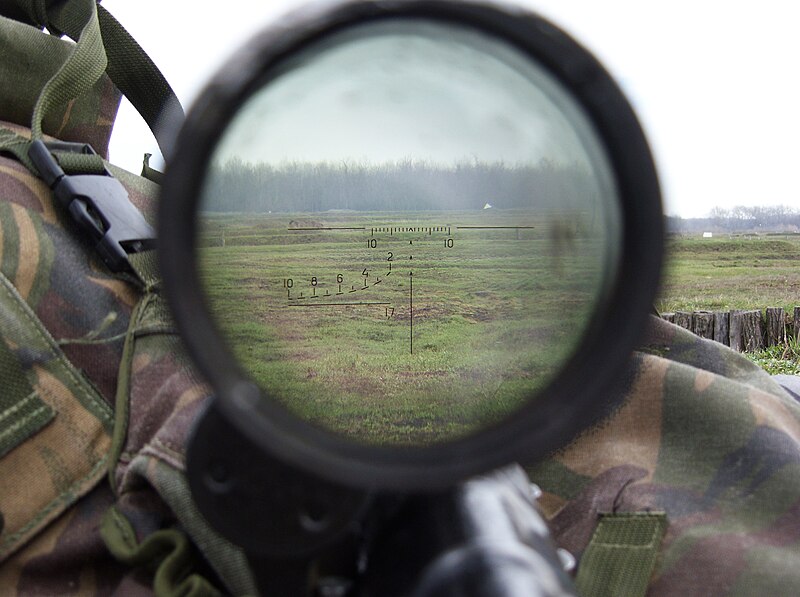Vidhwansak
Type Anti-materiel rifle
Place of origin India
Service history
In service 2007 -
Used by See Users
Production history
Designer Ordnance Factory Tiruchirappalli
Designed 2005
Manufacturer Ordnance Factory Tiruchirappalli
Produced February 2007[1]
Specifications (12.7 mm variant)
Weight 25 kg
Length 1.7 m
Barrel length 1.1 m
Crew 2
--------------------------------------------------------------------------------
Calibre 14.5x114mm, 12.7x108mm, 20x82mm
Barrels 8 Grooved, 1.1 m length, Quick Change type, 8 Grooved, 1.22 m Length, Quick Change type
Action Manual Bolt Action, recoiling barrel
Muzzle velocity 1,080 m/s
Effective range 1,800 m
Maximum range 2,000 m
Feed system Magazine
Sights 8X42 Power Telescopic sight with Parallax adjustment
Vidhwansak (Sanskrit:"The Destroyer")[2] is an Indian multi-caliber anti-materiel rifle (AMR) or large-caliber sniper rifle manufactured by Ordnance Factory Tiruchirappalli. It can be used in the anti-materiel role for destroying enemy bunkers, lightly armoured vehicles, radar systems, communication equipment, parked aircraft, fuel storage facilities, etc. It is also effective in long range sniping, counter sniping and ordnance disposal roles.[3]
It is being sold at the cost of Rs 10 lakh (about $20,000) as of 2011.
[edit] DevelopmentDenel was earlier contracted to supply various weapon systems for the Indian Armed Forces, including Anti-materiel rifles and Self-propelled howitzers. However, following allegations that it had paid kickbacks to secure a deal for anti-materiel rifles, Denel was black-listed by the government.
As a result Ordnance Factory Tiruchirapalli (OFT) in association with the
Defence Research and Development Organisation (DRDO) began developing an indigenous antimateriel rifle capable of similar role. Despite heavy visual and technical similarities to the Denel NTW-20 the guns have different calibers except for the 14.5 x 114 mm, ranges and price points. The development of Vidhwansak was completed in November 2005.[5] After all-terrain and all-weather trials, the user trials began in March 2006.[3]
Production began in February 2007. After trials, the Border Security Force ordered 100 Vidhwansaks for use in the border areas.[6] These were supplied by October 2008.[7] The rifle has also been offered to the Indian Army and the National Security Guards.[1][3] However, the Indian Army chose not to bring the Vidhwansak into use as it did not meet the weight requirements.[8]
The Vidhwansak is comparable to the NTW-20 in terms of caliber, size and performance. The Vidhwansak, which costs Rs 10 lakh (USD 20,000) is much cheaper than comparable foreign alternatives such as the Denel NTW-20 AMR, which costs Rs 23 lakhs (USD 45,000). It also supports multiple calibers and fires 12.7mm, 14.5mm and 20mm rounds compared to dual calibers supported by the NTW-20.
[edit] FeaturesVidhwansak is a manually operated, rotating bolt action rifle. The barrel along with the receiver recoil inside the chassis frame against a damping system. The rifle is fed from a detachable box magazine, that is inserted from the left side. The rifle can be quickly disassembled and carried in two man-portable packs, each weighing about 12 to 15 kg.[3] A muzzle brake is fitted on the end of the barrel which absorbs an estimated 50%-60% of recoil. This is further supplemented by a buffered slide in the receiver. Vidhwansak is equipped with an 8X magnification, long eye relief telescopic sight with parallax adjustment. A 12X ballistic scope can also be attached.
The rifle has an effective range of 1,800 m (1,300 m for the 20 mm version),[3] while shots can be achieved even up to 2,000 m. The rifle is magazine fed, and reloaded through manual bolt action.
[edit] VariantsVidhwansak AMR is one of few firearms to support 3 calibers with quick interchangeability (without completely disassembling and reworking the weapon). The Vidhwansak can be easily converted between the three calibers - 12.7 mm, 14.5 mm and 20 mm, by replacing the barrel, bolt, magazine and scope, which takes about 1 minute in the field, without the need for any specialized tools.
SpecificationsThe following are current specifications of the Vidhwansak AMR:[3][9]
Ammunition 12.7x108mm 14.5x114mm 20x 82mm
Weight 25 kg 29 kg 26 kg
Overall Length 1.7 m 2.015 m 1.795 m
Barrel 8 Grooved, 1.1 m length, Quick Change type 8 Grooved, 1.22 m Length, Quick Change type 8 Grooved, 1 m Length, Quick Change Type
Pitch of Rifle 1: 390 mm 1 : 420 mm 1 : 560 mm
Sights 8 X 42 power telescopic sight with parallax adjustment
Muzzle Velocity 845 m/s 1,080 m/s 720 m/s
Range 1,800 m 2,300 m 1,300 m
Users India: Border Security Force (more than 400 in service).
http://www.google.co.in/url?sa=t&rc...nIDoDg&usg=AFQjCNEK7GuMZ11AJteb6v0421mdBwzPrg
vidhwansak - Google Search

































